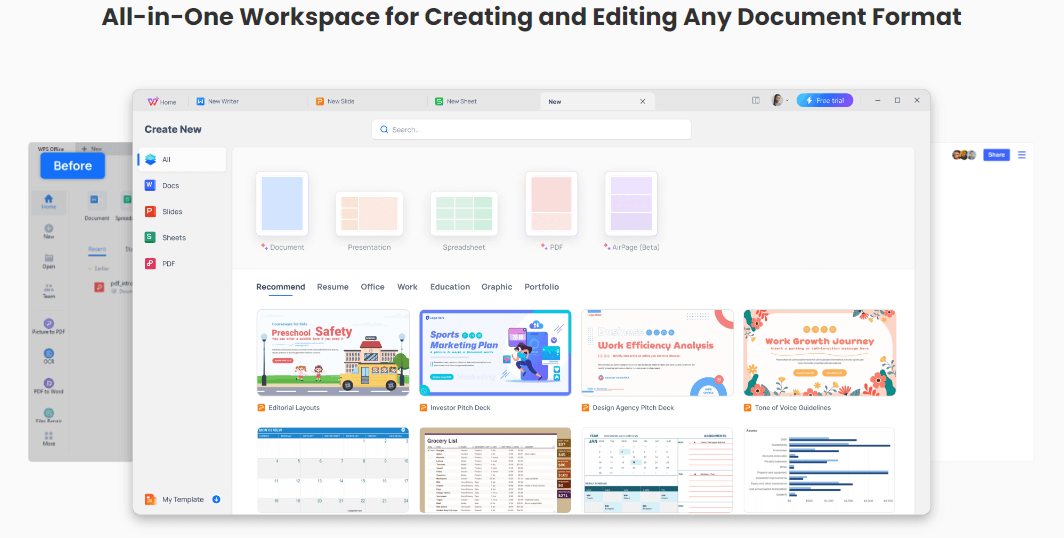Installing Microsoft Office on any device can be quite a time-consuming process, especially considering it's paid software. Even with the free version, there are several formalities to navigate. Nevertheless, Microsoft Office remains a robust productivity tool. That's why we've prepared a comprehensive guide to assist you in installing Microsoft Office on your Linux system. Linux, being an open-source operating system, offers the freedom of a versatile computing environment. With our guide, you can establish a robust system that enables seamless work across the various download methods we've outlined.
Linux and Microsoft Office Introduction
What is Linux?
Linux is often known as a prominent member of the UNIX operating system family, standing as a testament to the power of open-source software. At its core, Linux embodies the spirit of transparency and accessibility, as its source code is readily available to all who seek it. What's more, Linux extends a generous invitation to users, as it is entirely free to use.
The genesis of Linux bears the unmistakable mark of UNIX compatibility. This design philosophy fosters a sense of familiarity for those well-versed in UNIX systems. Linux's expansive repertoire of functionalities mirrors those of UNIX, cementing its position as a reliable and robust platform in the world of operating systems.
What is Microsoft Office?
Microsoft Office, a suite of computer applications, has been a cornerstone of business and office productivity since its inaugural release in 1990. Developed by the tech giant Microsoft Corporation, this software collection has since become a global standard, revolutionizing how organizations manage and streamline various office functions.
MS Office stands as a powerful toolset, simplifying fundamental office tasks and enhancing overall work efficiency. Each application within the suite is meticulously crafted to tackle specific tasks, covering a spectrum that encompasses word processing, data management, presentation creation, and email organization.
What sets Microsoft Office apart is its adaptability to diverse operating systems, making it accessible to a wide user base, including Windows, Linux, and macOS environments. Moreover, Microsoft has catered to a global audience by offering Office in a staggering 35 different languages, underscoring its commitment to serving diverse business and professional needs worldwide.
3 methods to install Microsoft Office on Linux
This step-by-step tutorial explores three methods of installing Microsoft Office on a Linux system. We will also help you compare each method which will guide you while choosing between them. Let's get started!
Method 1: Use Microsoft Office on the web in a Linux browser
Step 1: Open Your Linux Browser: Launch the Linux web browser
Step 2: Navigate to Office 365: Open your browser and navigate to the official Office 365 website.
Step 3: Sign In or Create an Account: Sign in if you have a Microsoft account. In case of not having one, you can always make one for free.
Step 4: Access Office Apps: After signing in, go to the "Apps" menu and choose the Office app you want to use, such as Word, Excel, or PowerPoint.
Step 5: Begin Using Office Online: You will be taken to the online version of the Office app you chose. Documents can be created, edited, and saved in OneDrive or locally.
Step 6: Save Your Work: You can save your work to your OneDrive account or download it to your Linux laptop.
As it does not require installation, using Office Online on a Linux browser is convenient. It does, however, require an internet connection and may have limited offline capability. It's fine for occasional use or collaborating on projects with others, but the online Office edition lacks some functionality included in the desktop version.
Method 2: Install Microsoft Office using PlayOnlinux
Step 1: Get PlayOnLinux and install it:
Install PlayOnLinux using the package manager included with your Linux system. You can do sudo apt install playonlinux on Ubuntu, for example.
Step 2: Launch PlayOnLinux:
After installation, launch PlayOnLinux from the applications menu.
Step 3: Install any required dependencies:
Install any PlayOnLinux-required libraries or dependencies by following the prompts. These will vary according to your distribution.
Step 4: Get Microsoft Office and install it:
In PlayOnLinux, click the "Install" button. Enter "Microsoft Office" into the search box and select your favorite Office version.
Step 5: Launch the Installation Wizard:
PlayOnLinux will guide you through the installation process, including determining the location of the installation file and its parameters.
Step 6: Complete the installation:
Following installation, you may utilize PlayOnLinux to launch Microsoft Office applications.
PlayOnLinux makes it simple to run Microsoft Office on Linux. It generates a virtual Windows environment to ensure compatibility. However, several advanced Office functions may not function properly, and you may have difficulties during upgrades. It's a good choice for customers that require the entire Office suite experience on Linux.
Method 3: Install Microsoft Office in a VM.
Step 1: Select Virtualization Software such as VirtualBox and install it on your Linux machine.

Step 2: Download Windows from the official Microsoft website.

Step 3: Launch your VM and select Windows as the installation media during setup.


Step 4: Based on your demands, configure VM settings such as RAM, CPU cores, and storage. Make sure you have enough resources to keep the Office working smoothly.




Step 5: Launch the virtual machine and follow the Windows installation tutorial. If necessary, activate Windows and connect it to the internet.

Step 6: Open a web browser within the Windows VM and navigate to the official Microsoft Office website. Sign in to your Microsoft account to buy or subscribe to Office 365. Download and install Microsoft Office.
Step 7: Once installed, you can use Microsoft Office within the Windows VM in the same way that you would on a Windows PC.
Running Office in a virtual machine gives you a full Windows environment for optimal compatibility. However, it uses more system resources and can make switching between Linux and Windows less seamless. It's perfect if you require extensive Office functionality or rely significantly on Windows-only software. Maintain frequent security and performance updates for both Windows and Office.
Although this strategy is highly compatible, it may not be the most resource-efficient solution for all users.
How to Use Microsoft Office on Linux?
Resonating Reminder:
While this method offers an avenue for using Office on Linux, it's important to acknowledge that it might not deliver the same performance and seamless integration as running Office on a native Windows system. To maintain ethical and legal compliance, ensure you're using a legitimately acquired copy of Microsoft Office, aligning with licensing agreements.
For troubleshooting and addressing compatibility concerns, don't hesitate to explore the PlayOnLinux website and engage with the vibrant community. Keep in mind that the compatibility of different Microsoft Office versions with Linux can vary, and certain features may have limitations or varying degrees of functionality. Stay informed to make the most of this approach.
Free Alternative to Microsoft Office — WPS Office
While Microsoft Office stands as a preferred choice for productivity users, its cost and limited compatibility beyond Windows and macOS can pose challenges for Linux users. In contrast, Linux, being an open-source system, finds a harmonious companion in WPS Office—a versatile and free alternative. WPS Office transcends operating system boundaries, seamlessly supporting Windows, macOS, and Linux environments. It even offers compatibility with Microsoft Office, enabling users to harness the strengths of both suites simultaneously. With a robust suite of tools encompassing Writer, Presentation, and Spreadsheet applications, WPS Office empowers users with all-in-one productivity solutions, ensuring they have everything they need to excel, all at no cost.

How to download WPS Office on Linux?
Below are the instructions for downloading WPS Office on your Linux system:
Step 1: Begin by visiting the official WPS Office website in your web browser.

Step 2: WPS Office aims to cater to all users, offering both Deb Package and Rpm Package options on the download page. Choose the one that matches your system.

Step 3: After downloading, navigate to your "Downloads" folder to locate the setup file.

Step 4: To proceed, perform right-click on the downloaded file and then choose the option "Open with GDebi Package Installer".

Step 5: You will encounter a download dialog, which will prompt you to click on the "Install Package" option located in the top right corner.

Step 6: For authentication purposes, input your device password.

Step 7: You can now access WPS Office by searching for it in the menu bar or simply clicking its desktop icon to launch the application.

Steps to edit Word/Excel/Powerpoint in WPS:
Editing Word documents, Excel spreadsheets, and PowerPoint presentations on Linux is now incredibly convenient with WPS Office.
Discovering the Power of WPS Writer
WPS Writer, the word processing application within WPS Office, offers a user interface reminiscent of Microsoft Word. It features familiar tabs and toolbars at the top, encompassing various capabilities. You'll easily locate dedicated buttons for actions like undo/redo, search and replace, printing, saving, and loading files. Furthermore, under the Review tab, you can conveniently access a word count feature to monitor the length of your document.

Mastering Spreadsheets with WPS Spreadsheet
WPS Spreadsheet, a powerful tool for managing Excel files on Linux, stands out for its unique feature of Combo charts, enabling the creation of charts with two distinct data representations in a single chart, making it suitable for tasks like histograms and line graphs. Additionally, it offers a wide range of computations, from basic calculations to complex formulas and standard deviations.

Elevate Your Presentation Skills with WPS Presentation
The WPS Presentation App simplifies Linux PowerPoint presentation creation and editing, incorporating Microsoft's Office suite interface for a familiar PowerPoint user experience.

FAQs
Q1. Why is Office not available on Linux?
At present, Microsoft Office is not natively available for Linux because Microsoft didn't design it to function on the Linux Operating system. Having said that, if you want to use older versions of Office on Linux, you can use a program called Wine. Wine, a compatibility layer, makes Linux appear like Windows to the older Office versions by reverse engineering the Windows system library calls, allowing them to work on Linux. People can also utilize other substitutes, such as Microsoft Office 365 online or office software like LibreOffice that is compatible with the Linux Operating System.
Q2. Why should I switch to Linux?
Switching to Linux is a good idea for the following list of reasons;
User-Friendly: Linux is easy to use with graphical interfaces that don't require advanced technical skills.
Flexibility and Control: Linux is highly customizable, allowing you to personalize your desktop environment.
Security: Linux is known for its robust security, making it less susceptible to viruses.
Community Support: The Linux community is ready to assist with advice and solutions.
Open Source: Linux is open source, meaning anyone can view, modify, and contribute to the source code.
Efficient and Reliable: Linux is speedy and reliable, even on older hardware, making it a sustainable choice.
Wide Compatibility: Linux is compatible with various devices, which helps you save money on costly hardware upgrades.
Abundance of Choices: Linux offers numerous distributions (distros) with distinctive features and purposes, including Ubuntu, Fedora, and Debian.
Enhanced Security: Linux often demands a user password for tasks that require higher permissions, strengthening security.
Regular Updates: Keeping your Linux system and software up to date is crucial for security, but most Linux distributions make this process straightforward.
Linux Magic: Microsoft Office Guide
In this article, you've gained insights into the seamless installation of Windows on your Linux system, thanks to a range of available methods. However, concerns about compatibility persist for many users. That's where WPS Office steps in as a versatile and free solution designed to accommodate everyone, regardless of their operating system. Tailored to meet the unique requirements of each OS, WPS Office ensures your productivity needs are met effortlessly. Unlock the potential of WPS Office by downloading it now.





